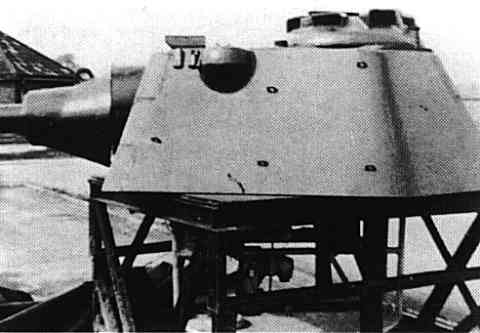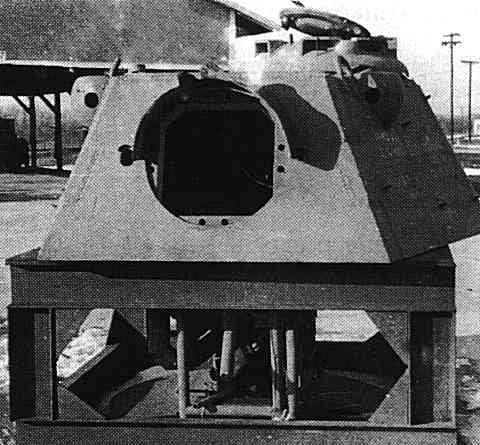PANTHER Ausf. F
|

|
| Sketch of the Panther
Ausf.F (Hilary Doyle) |
|
Specifications |
Panzerkampfwagen
V Ausf. F (SdKfz 171) |
| Manufacturer: |
Daimler-Benz,
did not go into series production. Reports indicate that 8 hulls
were produced in 1945, but only prototype turrets had been completed
at this time |
| Chassis
No.: |
? |
| Produced: |
8
hulls and 3 prototype turrets |
| Crew: |
5 |
| Weight: |
45
tons |
| Lengh: |
8,86
m |
| Width: |
3,44
m |
| Height: |
2,92
m |
| Engine: |
Maybach
HL230P30 |
| Gearbox: |
7
forward, 1 reverse |
| Speed: |
55
km/h |
| Range: |
200
km |
| Radio: |
FuG
5 |
Already in 1943 attempts
had been made to redesign the Panther turret. Drawing H-Sk A 86176, dated
7 November 1943 entitled "Turm Panther 2 (Schmale
Blendenausführung)", reveals a redesigned turret with a narrow gun
mantlet with the coaxial machinegun mounted behind a 120 mm thick turett
front plate.
During the Spring of 1944,
responsibility for detailed design of the new turret was transferred from
Rheinmetall to Daimler-Benz. The specifications for a new turret as given
to Daimler-Benz by WaPruef 6 were:
-
Elimination of the
possibility of shots being deflected off the curved mantlet into the
driving department.
-
Increase in armour
protection without corresponding increase in weight of the turret.
-
Reduction of the
frontal area exposed to attack without restricting the space within
the turret required for servicing the gun.
-
Installation of a
stereoscopic rangefinder.
-
Substitution of a
coaxial MG42 instead of a MG34.
-
Reduction of
production costs of the turret.
-
Installation of
the necessary accessories to enable the complete tank to be quickly
converted by personnel into either a commander´s tank
(Befehls-Panther) or a night fighting Panther with infrared sighting
gear.
The new turret was to have
the same size turett ring as the previous Panthers and it was intended to
be mounted on the Panther F and Panther II.
Further design process is
revealed in conceptual design drawing H-Sk 88517 by Rheinmetall entitled
"Turm-Panther (schmale Blende)" dated 1 March 1944. Within this drawing
of a new turret design the reduction of the width of the turret front and gun mantlet, and
the inclusion of an internally-mounted range finder as well as a periscopic
gunsight can be seen. The range finder was accommodated by creating a massive hump in the turret roof. The Rheinmetall design was not exactly what Wa Prüf 6 had in mind, however, and Daimler-Benz was awarded contracts to complete a new turret design, designated Schmalturm (narrow turret).
|
 
|
| The hatch for the
commander´s cupola was hinged at the back instead of being lifted
and pivoted on a shaft. Other features included: five rings welded
on each side to aid in attaching camouflage, three brackets for
fastening Losterkennungstafeln (poison gas warning panels) to the
turett roof, three Pilze (mounts) for the 2t Kran, a radio antenna
base on the turett roof, and a machinegun port in the turett rear.
Armoured components for this turett were manufactured at the
Dortmund Hoerden Huetten Verein steel works |
By using a new type of gun
mantlet, it was possible to have a much narrower turret front plate (about
950 mm at the top and 1500 mm at the bottom) and so reduce the area
exposed to attack. The turett front consisted of a homogenous plate which
did not require expensive machining of an armour steel casting as did the
old Panther turret. It was possible to increase the armour thickness
without increasing the overall weight of the turett (7,565 tons compared
with 7,665 tons of the old turret), owing to the narrower front plate, the
new type of gun mantlet and simplification of certain installations in the
turret.The width of the turret was reduced by redesigning the gun mount, and relocating the recoil cylinder and recuperator below the gun instead of on either side. Armour protection for the Schmalturm consisted of a 120 mm-thick front plate at an angle of 20 degrees, 60 mm-thick side and rear plates at an angle of 25 degrees, and a 40 mm thick flat roof plate. Armament consisted of the 7.5 cm KwK44/1 L/70 gun with a coaxial mounted MG42.
Features of the new turret
included:
-
A
Nahverteidigungswaffe in the offside rear of the turret roof
-
A redesigned
commander´s cupola.
-
A pistol port in
the turret rear plate. This was found to be essential following
experience gained in fighting the Russians, who made a point of
stalking tanks from the rear.
-
A rangefinder
fitted just behind the turret front plate
|
Armament |
7,5
cm KwK44/1 L/70 |
7,92
mm MG 42 (coaxial) |
MP 44 (hull) |
| Traverse: |
360°
hydraulic |
360°
hydraulic |
hand |
| Elevation: |
-8°
+20° |
-8°
+20° |
|
| Sight: |
EM
1,25 R (Pz) TZF 13 |
EM
1,25 R (Pz) TZF 13 |
KgZF
2 |
| Ammunition: |
79 |
? |
|
|

|
| The necessary changes
for the KwK44/1 L/70 to fit into the Schmalturm were carried out
by Skoda in cooperation with Krupp |
Initial plans were to
mount a monocular, articulated TZF13 telescopic sight, developed by Leitz,
Wetzlar, in the Schmalturm. The TZF13 had dual magnification selectable at
2,5x and 6x. A new stabilised,
periscopic SZF1 gunsight was intended to be installed during series
production with it´s head protruding through the turret roof. A trial
series of 10 SZF1 stabilized gun sights were ordered from Leitz in 1944,
followed by a series production order of 1000 in January 1945.
The commander's cupola still had seven periscopes. In comparison to the cast commander's cupola on the Panther Ausf.A and
Ausf.G, the commander's cupola on the Schmalturm was lower, had a hinged hatch, and was drilled so that a
TSF1 spotting periscope could be raised without opening the commander's hatch. The fume extraction fan was relocated to the turret base plate to the right of the gun instead of on the turret roof.
 |
| Rheinmetall designed a
Panther turret with a narrow gun mantlet, periscope sight, and
built-in range finder as drawing No. HSK 88517 dated 1st March
1944 entitled "Turm-Panther (Schmale Blende)" (Panther
turett with narrow gun mantlet). The height of the turett roof was
increased to 960 mm to accommodate the range finder. |
|
Armour |
Front |
Side |
Rear |
Top/Bottom |
| Turret
(mm/angle) |
120/20° |
60/25° |
60/25° |
40/90° |
| Hull
(upper) |
80/55° |
50/30° |
|
40-25/90° |
| Hull
(lower) |
50/55° |
40/0° |
40/30° |
25-16/90° |
| Gun
mantlet |
150/Saukopfblende |
|
|
|
The new Panther created by mounting the new Schmalturm on a modified Panther Ausf.G chassis was officially designated the Panther Ausf.F.
Apart from the Schmalturm, when compared with the Ausf.G the following
changes were to be introduced with the Ausf.F:
-
Main hull roof
plate thickened from 16 mm to 25 mm
-
New design for the
hatch for the driver´s and radio operator. To open the hatch the
cover was slightly raised and then slid to the side.
-
Modified driver´s
periscope mount
-
Hull MG34 replaced
with a ball mounted MP44
-
Radio equipment
and installations so arranged that the tank could be converted from a
normal fighting vehicle in a commander´s tank by unit personnel in
the field
-
Every Ausf.F was
to be equipped with the necessary accessories for use with the
infra-red night sighting equipment FG1250, so that the FG1250 infrared
scope and searchlight could be fitted by unit personnel at any
time
|
 
|
| This Schmalturret
shipped to Aberdeen Proving grounds for examination is unique in
that there is an aperture in the turett front for a telescopic
sight but it does not have an aperture for a periscopic sight. The
five rings welded to the turret side and the brackets for
fastening the poison gas warning panels attest to to the fact that
this turret was being assembled in a normal production series. |
As planned in October 1944, delivery of the completed Panther Ausf.F was to start at Daimler-Benz in March 1945. However, production was delayed by bombing raids. Panther Ausf.F chassis and turrets were on the assembly line at Daimler-Benz in April 1945. lf Daimler-Benz did manage to complete a few Panther Ausf.F between 20 and 23 April 1945, their operation would have been impaired because key components were not available for the Schmalturm, including the range finders and gunsights.
|

|
| Another view of the
Versuchs-Schmalturm for WaPruef 6 mounted on a Panther G chassis. |
The Panther Ausf.G turret would not fit on the Panther Ausf.F chassis without altering the turret race and turret drive, and this at a time when there were constant power failures. lf this had been done at Daimler-Benz, as representatives from
MAN stated when interrogated directly after the
war, the end result would have been just like any other Panther Ausf.G, but with sliding hatches and an MP44 ball mount.
|

|
| A second
Versuchs-Schmalturm mounted on a Panther G chassis. The chassis
(FgstNr. 120413) was completed by MAN for issue to the troops in
early May 1944. No hole is evident for a telescopic gun sight in
the turret front, only a periscope projecting through the turret
roof. The sheet metal debris guard covering the gap between the
gun mantlet and the turret front had not been welded on. |
When interrogated on 3
September 1945, without benefit of any supporting documents,
representatives from MAN stated that the Ausf.F had steel-tyred,
rubber-cushioned roadwheels mounted in staggered pairs. The type of
roadwheels was not mentioned when representatives of Daimler-Benz were
interrogated after the war in July 1945. However, on 20 February 1945,
WaPruef reported that "Gummisparende Laufwerke" (steel-tyred,
rubber cushioned roadwheels) were being developed for all types of Panzers
(not only the Panther Ausf.F). Development was scheduled to be completed
by May 1945. Actual introduction in the production line would have occured
later.
Daimler-Benz representatives were not asked about, nor did they comment on, their success in producing a few Panther Ausf.F at the Daimler-Benz assembly plant in Berlin-Marienfelde.
But with a report it was possible to prove due to the Fgst.-Numbers that
all Panthers which were delivered in the final days of the Reich by
Daimler-Benz before production ended on 24th April 1945, were of Ausf.G
type. If some few Panther F would have been completed, they would
have been handed over to II./Panzerregiment 2 in April 1945, for immediate
action in the defence of Berlin.
|